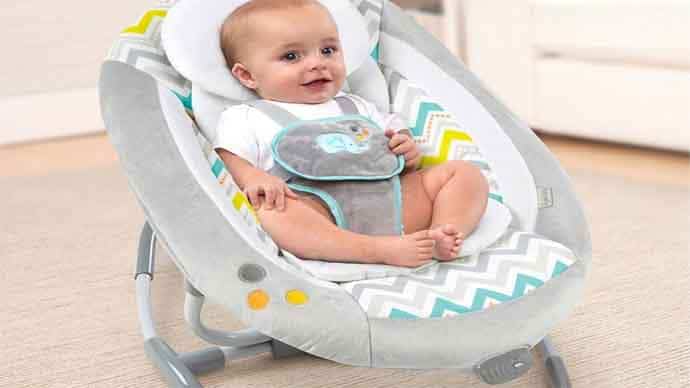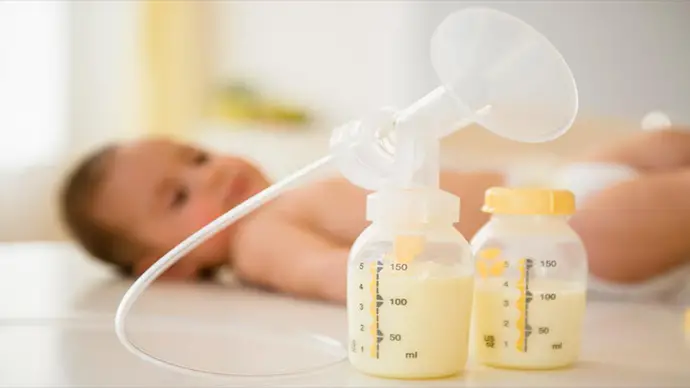Breastfeeding is a wonderful bonding experience for mom and baby, but if you’ve decided that you are formula feeding your baby instead of breastfeeding, it can be tricky figuring out how to get off to a good start. In this article, I’ll share some tips and tricks that I use with my clients every day. I hope these 18 formula feeding tips and hacks will make mealtime with the baby the most rewarding time for you both.
1) Make A Batch Of Formula In Advance.

A lot of parents prefer preparing a generous batch of formula for at least the first month. You can make it in advance, store it in the fridge and take one scoop every time you plan to feed your baby. This will help free up your time and ensure that you always have some ready.
2) Invest In A Good Bottle Warmer.
A good bottle warmer can be a real-time saver, especially if you are a working parent. A bottle that is not heated evenly can cause digestion issues and gas problems for your baby. With a good bottle warmer, you don’t need to worry about this problem anymore.
3) Learn About Different Nipple Sizes
Baby bottle nipples come in different sizes, so you need to be aware of the size of your baby’s mouth.
Ensure that your baby is on a “smallest” nipple size for the type of formula you are giving him. This will ensure your baby gets enough food without choking on the nipple. Also, the nipple should not be too small as it can cause a gag reflex.
If you have a newborn baby, you could use a preemie nipple which is specially designed to prevent colic.
The size of bottle nipples also varies based on whether they are meant formula feeding or breast milk.
At about 3 months your baby might get angry and push away from bottle feeding . This could be a sign your child needs to go on the next “nipples size”, which has a more spacious opening for the baby formula to flow. The same incident may again happen around 7 months .
Depending on the baby, they might be able to go up to the next size in their first year of age.
4) Check Your Bottles For Cracks And Keep A Sterilizer.
Your baby’s health and safety are your top priority. Check for cracks in the bottle, or any other damage that could make your baby sick after drinking from it. You can also use a baby bottle sterilizer to keep the bottles safe from bacteria.
If you buy plastic be careful about BPA content in the bottle. Some parents have reported their infants getting problems of throat and stomach after the babies were fed with plastic bottles.
If you plan to use a glass bottle or one made of any other material, it is better to get BPA free bottles.
In my experience, those that use BPA free bottles were also using reusable nipple bottles and the babies generally don’t have any kind of problems with these bottles.
Glass bottles are generally more expensive although it is worth the extra cost for safety.
However, A glass bottle can get easily breakable anytime. So do not make the mistake of buying a single bottle for your baby because they are expensive and you may end up breaking them within the first few months or so when your baby is still a newborn.
As for bottle nipples take care of them appropriately. We have a baby pacifier sterilizer that we use to sterilize the nipples after their first use. Make sure you clean and wash them very well using warm water and mild detergent.
Some people like to give them a quick rinse in hot water. Most bottle nipples and feeding bottles are dishwasher safe, so they can be used with them as well.
5) Use One Brand Of Bottles And Pay Attention To The Bottle Nipples
Your life will be easier with a certain type of bottle. You can interchange all parts and never worry about the wrong parts of the nipples or the wrong nipple size for your baby.
We use Dr. Brown’s bottles for our daughter from the start. They have 3 different types of nipples which we can interchange, one is preemie size, one is newborn size, and one is regular sized. The nipples are also interchangeable with other brands which we find to be very useful when it comes to traveling or going out with friends and family as you just need to take all the spare parts along with you.
6) Don’t Warm The Water Early In The Morning
The room temperature is perfect for bottle feeding. If you are used to warming up baby formula before feeding your baby, make sure you don’t increase the temperature in your home so much that it will warm up too much and make little residual heat.

In my experience, I have never warmed the water in the morning. When my son was a newborn he liked breast milk even if it was not very warm.
What I do is add a little bit of breast milk to our bottle warmer which makes it warm enough for him to start feeding without warming it.
If you have a good bottle warmer, just fill it up with water and wait for a few minutes and it will be good to go.
7 ) Switch Each Nipple Around
If you have formula bottles, it is important to change the nipples regularly. Babies tend to favor one nipple over another and will prefer to feed on a particular nipple instead of the usual one. This will make them develop bad habits and you will have to constantly switch from bottle to bottle to prevent problems.
8) Get Big Brother Or Big Sister To Help Make Formula
It’s a useful way to include older siblings in the care of your baby. They can help give the baby a bottle, help pat the baby’s bottom so he doesn’t get too hot, and help out with cleaning up.
Sometimes my older one was helping me to put the bottles “together” when I took it off the dishwasher. He would arrange them and assist in assembly. It was a perfect way by which he felt like we were a team.
9) Get Into A Comfortable Bottle-Feeding Position
Make sure you are in a comfortable and safe position when you feed your baby. If you want to use one hand, keep the other hand free in case you need to do anything else like change the baby’s diaper, take her out of her swaddle or stop her from pulling off her soother.
Also ensure you don’t put yourself in any position where your baby can fall off or slip and fall onto hard surfaces like a sofa or coffee table. Having a pillow by the side in case the arms are too tired and the baby wants to sleep.
10) Let Your Partner Introduce The Bottle

Babies who drink breast milk often shy away from taking bottle from mother.
Allow your partner to take the baby for a bottle feeding when you are busy and it is difficult to attend the baby.
This will help facilitate the transition and create the way for future feeding without mom taking the bottle.
11) Feed Your Baby In A Quiet Room
Some babies get very happy when they eat. If this is the case for you, feed your baby in a quiet room away from loud toys and bright light. This will help him concentrate on his feeding and enjoy it without distractions.
12) Monitor Your Baby’s Poop
It is easy to forget about poop. Monitor your baby’s bowel movements and make sure he doesn’t have any diarrhea. It is important to feed your baby at regular intervals and watch his poop. This will help you know when it is time for the next feeding and if there is a need for a change of formula or milk.
Some babies are very fussy eaters with no bowel movements at all. Some babies have just one bowel movement every 48-72 hours. Babies who are breastfed have to feed every two hours and it is easy to know if they need a bottle. Bottle-fed babies may not poop for 4-5 days. This is normal and may be a cause of the teething as well. Babies who don’t poop at all may need additional amounts of formula or food in their diet such as cereal to help them stool (pass.).
Keeping a watch on your baby’s poop will also help identify any dairy intolerance. Some babies do have lactose intolerance and can develop diarrhea. You may need to stay away from all dairy products and check with your dietitian or pediatrician for a formula change which may include prebiotics.
13)Make A Big Batch Of Formula
Making a large batch of formula in advance is a good idea so that you can use the formula for last-minute feeding. This can also be helpful if you are going on vacation and would like to be prepared with all the bottles filled and ready to go.
If you plan to skip this step, make sure you have extra bottle nipples to switch out so that it doesn’t double up.
14) Snuggle With Your Baby While Feeding
We love snuggling with our son. He tends to fall asleep as soon as he senses that we are coming near him. Being a parent is sometimes very hard work, which can be prolonged by fatigue and stress. Snuggling will relax you and make it easier for you to help your baby in all ways possible.
15) Prepare For Night Feedings Before Your Head Hits The Pillow.

Pre-planning and prepping for nighttime feedings is the best way to make this process easier. Make sure you do all you can to prepare yourself.
Have the formula pre-measured and plenty of bottles ready.
Be prepared for any mishaps such as accidents and tears. Have extra bottles and nipples ready so that the feeding process is faster.
Any leftover formula should be discarded as it can cause diarrhea if given to your baby.
16)Stock Your Bottle Station
Designate an area of the countertop where you can place a bottle storage unit full of everything. This will save you the hassle of constantly looking for things on your part. If you have more bottles than you need, you can make new storage units as required.
Your bottle station should have a roll of toilet paper and paper towels, scissors and a couple of washcloths, a bottle warmer, a dish of warm water to use with the warmer for warming milk or bottled water , and disposable cups or bowls for feedings.
17) Keep A Feeding Diary For Your Baby

Making a note of all the feedings will help you know how frequently your baby should be fed.
You can make note of when she sleeps and how long it takes her to feed.
This is very important information for both you and the doctor.
When you note down the last feeding time, make sure you write down what time it was. Many parents forget to do this and this can cause confusion when you ask the pediatrician, “When did he last eat?”
This may be a big problem when diagnoses are made and medical treatment is decided.
You may also include notes about what you were doing before the feeding, your overall health, any medications taken, and if you have been hospitalized for your baby. An admission medical record will help the pediatrician in diagnosing and treating your baby.
18) Get Very Familiar With Burping And Baby Gas
Burping needs to be done after every feeding session so that the baby’s tummy does not get too full. Babies who overindulge on milk will develop gas and are usually fussy. This is a well-known fact and many parents find it strange when some gassy babies still have constipation. Babies cannot communicate their pain very well and it is up to us as parents to know the signs by instinct.
Burp your baby after every feeding or at least every 2-4 bottles of formula or milk. Read more about newborn burping techniques here.
After the feeding end, clean the bottle nipples as you will no longer use them twice. Hold the baby’s stomach upright and gently massage it with one hand while burping with the other. This helps get rid of gas in the body.
After burping, do not give your baby any more food for a few minutes. It is very important for babies to have soft stools because they are still growing physically and mentally.
How To Prepare Baby Formula For On-The-Go Feedings?
If you are planning to travel out of town or even just across town, you should have everything ready and all the bottles pre-measured. If you are staying at a hotel, it is best to pack your baby’s bottles and food with you. You can also buy formula at a nearby store if there is no time for preparation.

When I know I will be out of town, I always make sure to have bottles and food ready before I leave.
Another good idea would be to buy a waterproof cooler bag and bring a few ice packs as well.
Make sure you pack the formula, disposable nipple covers or bags, diapers, wipes and extra onesies.
In conclusion, as you can see, feeding your baby is not that difficult if all the pre-requisites are taken care of. You just need to prepare for the challenges and obstacles in order to meet them head-on. Feeding is not only about providing nutrients to your baby, it is about bonding with them and becoming one. Remember that the first few months of your baby’s life are very important for her development.
You may also like to read about:





![Can I Eat Ice Cream While Breastfeeding?[Answered]](https://www.newmomstuff.com/wp-content/uploads/2021/07/mom-eating-ice-cream.jpg)

